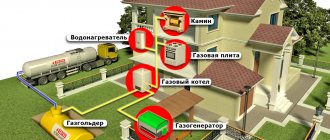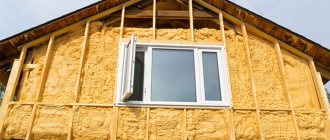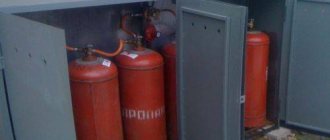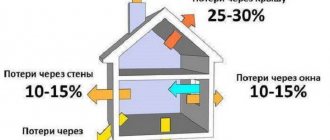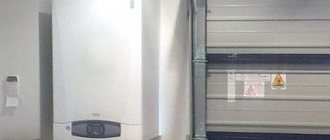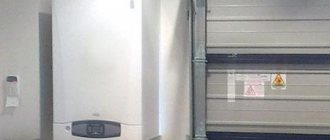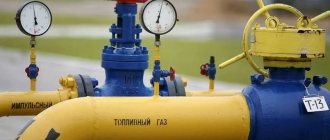Calculation method for natural gas
The approximate gas consumption for heating is calculated based on half the power of the installed boiler. The thing is that when determining the power of a gas boiler, the lowest temperature is set. This is understandable - even when it is very cold outside, the house should be warm.
You can calculate gas consumption for heating yourself
But calculating gas consumption for heating using this maximum figure is completely incorrect - after all, the temperature is generally much higher, which means much less fuel is burned. That’s why it is generally accepted that the average fuel consumption for heating is about 50% of the heat loss or boiler power.
We calculate gas consumption by heat loss
If you don’t have a boiler yet, and you estimate the cost of heating in different ways, you can calculate it from the total heat loss of the building. They are most likely known to you. The technique here is this: they take 50% of the total heat loss, add 10% to provide hot water supply and 10% to remove heat during ventilation. As a result, we obtain the average consumption in kilowatts per hour.
Next, you can find out the fuel consumption per day (multiply by 24 hours), per month (by 30 days), and, if desired, for the entire heating season (multiply by the number of months during which the heating operates). All these figures can be converted into cubic meters (knowing the specific heat of combustion of gas), and then multiply the cubic meters by the price of gas and, thus, find out the heating costs.
| Crowd name | Unit | Specific heat of combustion in kcal | Specific heat of combustion in kW | Specific heat of combustion in MJ |
| Natural gas | 1 m 3 | 8000 kcal | 9.2 kW | 33.5 MJ |
| Liquefied gas | 1 kg | 10800 kcal | 12.5 kW | 45.2 MJ |
| Coal (W=10%) | 1 kg | 6450 kcal | 7.5 kW | 27 MJ |
| Wood pellets | 1 kg | 4100 kcal | 4.7 kW | 17.17 MJ |
| Dried wood (W=20%) | 1 kg | 3400 kcal | 3.9 kW | 14.24 MJ |
Example of heat loss calculation
Let the heat loss of the house be 16 kW/hour. Let's start counting:
- average heat demand per hour - 8 kW/h + 1.6 kW/h + 1.6 kW/h = 11.2 kW/h;
- per day - 11.2 kW * 24 hours = 268.8 kW;
- per month - 268.8 kW * 30 days = 8064 kW.
The actual gas consumption for heating also depends on the type of burner - modulating ones are the most economical
Convert to cubic meters. If we use natural gas, we divide the gas consumption for heating per hour: 11.2 kW/h / 9.3 kW = 1.2 m3/h. In calculations, the figure 9.3 kW is the specific heat capacity of natural gas combustion (available in the table).
By the way, you can also calculate the required amount of fuel of any type - you just need to take the heat capacity for the required fuel.
Since the boiler has not 100% efficiency, but 88-92%, you will have to make further adjustments for this - add about 10% of the obtained figure. In total, we get gas consumption for heating per hour - 1.32 cubic meters per hour. Next you can calculate:
- consumption per day: 1.32 m3 * 24 hours = 28.8 m3/day
- monthly demand: 28.8 m3/day * 30 days = 864 m3/month.
The average consumption for the heating season depends on its duration - multiply by the number of months while the heating season lasts.
This calculation is approximate. In some months, gas consumption will be much less, in the coldest month - more, but on average the figure will be about the same.
Boiler power calculation
The calculations will be a little simpler if you have the calculated boiler power - all the necessary reserves (for hot water supply and ventilation) have already been taken into account. Therefore, we simply take 50% of the calculated capacity and then calculate the consumption per day, month, per season.
For example, the design power of the boiler is 24 kW. To calculate gas consumption for heating, we take half: 12 k/W. This will be the average heat demand per hour. To determine fuel consumption per hour, we divide by the calorific value, we get 12 kW/hour / 9.3 k/W = 1.3 m3. Then everything is calculated as in the example above:
- per day: 12 kW/h * 24 hours = 288 kW in terms of the amount of gas - 1.3 m3 * 24 = 31.2 m3
- per month: 288 kW * 30 days = 8640 m3, consumption in cubic meters 31.2 m3 * 30 = 936 m3.
You can calculate gas consumption for heating a house using the design capacity of the boiler
Next, add 10% for the imperfection of the boiler, we find that for this case the consumption will be slightly more than 1000 cubic meters per month (1029.3 cubic meters). As you can see, in this case everything is even simpler - fewer numbers, but the principle is the same.
By quadrature
Even more approximate calculations can be obtained based on the square footage of the house. There are two ways:
- You can calculate according to SNiP standards - on average, heating one square meter in Central Russia requires 80 W/m2. This figure can be used if your house is built according to all requirements and has good insulation.
- You can estimate based on average statistical data:
- with good insulation of the house, 2.5-3 cubic meters/m2 is required;
- with average insulation, gas consumption is 4-5 cubic meters/m2.
Review of imported and Russian manufacturers of propane boilers
To begin with, let’s make a reservation that before purchasing you should find out about the parameters (technical characteristics) by which boilers of this type are usually selected.
- Power. It depends on it whether the equipment will heat the entire area of the building and whether it will provide the required amount of hot water.
- Boiler type. According to the method of installation, there are wall-mounted and floor-standing boilers, according to the type of combustion chamber - open and closed, and if it is possible to provide hot water - single-circuit and double-circuit.
- Gas pressure. The passport of the heating unit must indicate the minimum value of gas pressure in the range of 3-4 mbar. After all, the lower the indicator, the greater the volume of gas will be released from the cylinders.
- Gas consumption. To generate 1 kW of heat, a cylinder boiler consumes about 0.12 kg/h. It turns out that for a heat generator with a power of 15 kW, fuel consumption will be about 1.7 kg/h. These figures are conditional, because the intensity of liquefied gas consumption depends on many nuances (equipment efficiency, power, level of automation, outside air, required temperature in the house, heat loss of the building, need for hot water).
- Efficiency The operation of the equipment will be more economical and efficient if the efficiency is higher. On the market you can choose gas boilers with an efficiency of 90 to 94%.
Before purchasing liquefied gas boilers, calculations are carried out that show the profitability of the installation, as well as the features of maintenance and operation of the heating system.
The average monthly consumption of liquefied gas for heating a house of 150 m² is about 841.5 liters per month.
Boilers operating on liquefied gas, Russian-made and foreign-made, differ in prices. Many companies offer heating devices that can be switched to run on liquefied gas.
Brands of gas heating boilers:
- Italian brand "Baxi";
- Protherm (Slovakia);
- Zhukovsky Machine-Building Plant (ZhMZ) produces two types of gas boilers - AKGV and AOGV;
- Factory Conord.
| Manufacturer and model | Efficiency, % | Maximum thermal power, kW | Overall dimensions (HxWxD), mm | Description and differences |
| Baxi ECO Four 1.24 | 90,9 | 24 | 730x400x299 | Single-circuit wall model. Atmospheric burner. Copper heat exchanger. When the pressure drops to 4 mbar it works stably. Electronic ignition. Built-in pump. |
| Baxi MAIN 5 14 F | 92,9 | 14 | 730x400x299 | Wall-mounted boiler with DHW circuit. Electronic atmospheric burner. Bithermic heat exchanger. When the pressure decreases it works up to 4 mbar. Electronic anti-scale fuse. |
| Protherm Cheetah 11 MOV | 88,4 | 11,0 | 742x410x311 | Double-circuit wall model. Heat exchanger "pipe in pipe". Natural cravings. Built-in microprocessor. Winter-summer function. |
| Protherm Panther 25 KTV | 92,8 | 24,6 | 742x410x311 | Double-circuit boiler. The combustion chamber is closed. Information display. Minimum pressure 5 mbar. Anti-freeze function. |
| ZhMZ Comfort AOGV-11.6-3 | 86,0 | 11,6 | 850x310x412 | Floor. The combustion chamber is open. Built-in piezo ignition. German automatic equipment Mertik Maxitrol. Steel heat exchanger. |
| ZhMZ Universal AKGV-17.4-3 | 88,0 | 17,4 | 1050x420x480 | Double-circuit floor-mounted equipment. SIT automation. Heat exchanger made of stainless steel. |
| Concord DON KS-TG-16/20S | 90 | 20 | 775x405x1070 | Combination boiler: can operate on both gas and solid fuels. Honeywell - American draft regulator. Adaptation to hard water. |
Thus, heating a private house, cottage or bathhouse using a boiler running on liquefied gas is a good alternative to other heating options. Moreover, this type of fuel is widespread almost everywhere.
Calculation of liquefied gas consumption
Many boilers can run on liquefied gas. How profitable is this? What will be the consumption of liquefied gas for heating? All this can also be calculated. The technique is the same: you need to know either the heat loss or the power of the boiler. Next, we convert the required quantity into liters (units of measurement of liquefied gas), and, if desired, we count the number of required cylinders.
Let's look at the calculation using an example. Let the boiler power be 18 kW, respectively, the average heat demand is 9 kW/hour. When burning 1 kg of liquefied gas, we obtain 12.5 kW of heat . This means that to get 9 kW, you will need 0.72 kg (9 kW / 12.5 kW = 0.72 kg).
- per day: 0.72 kg * 24 hours = 17.28 kg;
- per month 17.28 kg * 30 days = 518.4 kg.
Let's add a correction for the boiler efficiency. We need to look at each specific case, but let’s take 90%, that is, add another 10%, it turns out that the monthly consumption will be 570.24 kg.
Liquefied gas is one of the heating options
To calculate the number of cylinders, divide this figure by 21.2 kg (this is the average kg of gas in a 50 liter cylinder).
Mass of liquefied gas in various cylinders
In total, this boiler will require 27 liquefied gas cylinders. Calculate the cost yourself - prices vary in the regions. But don't forget about transportation costs. By the way, they can be reduced by making a gas holder - a sealed container for storing liquefied gas, which can be refilled once a month or less often - depending on the storage volume and demand.
Again, remember that this is just an approximate figure. In cold months, gas consumption for heating will be higher, in warm months it will be much less.
PS If it is more convenient for you to calculate the consumption in liters:
- 1 liter of liquefied gas weighs approximately 0.55 kg and, when burned, produces approximately 6500 kW of heat;
- There are about 42 liters of gas in a 50 liter cylinder.
Autonomous gasification has two significant columns in the estimate: installation of a gas tank and annual fuel consumption. We'll tell you how much you will spend on liquefied petroleum gas (LPG) when living in an area from 50 to 800 m2.
The entire article in 1 table
Popular house sizes
Gas consumption per month
Gas consumption during the heating season (7 months)
Gas consumption per year
LPG at a price of 17.80 rubles/l as of 01/29/2019.
How to calculate the need for thermal energy
The simplified formula for this calculation looks very simple - 1 kW of thermal energy is spent on heating 10 m2 of building area. A more accurate formula operates not with areas, but with the cubic capacity of the house, also taking into account the height of the ceilings in the room. But for standard-type dwellings with a ceiling height of 2.5-2.7 meters, the above simplified proportion is valid. Accurate calculation of the need for thermal energy operates not only on the volume of heated space, but also on the heat resistance of walls, openings and ceilings
In addition, in this case, the average annual temperature and other nuances are taken into account.
Boiler room
However, in order to calculate the volume of fuel, a simple formula will be enough for us: 1 kilowatt = 10 square meters. As a result, heating a building with an area of 150 or 200 square meters requires spending 15 or 20 kW, respectively. And this is only an hour. But the boiler does not consume gas every minute. The work/downtime period here is divided in the proportion of 50/50 percent. Therefore, per day, a house with an area of 150 square meters will spend 180 kW (15x24/2), and a home with an area of two hundred square meters will spend 240 kW.
Liquefied gas consumption per month and year
Let's go over the costs of refilling a gas tank for houses of different sizes. We use the LPG price current at the beginning of 2022 - 17.80 rubles/l. This is the cost of refueling in our company.
House area (m2)
Gas consumption per month (l)
Gas price per month (RUB)
Gas consumption per year (l)
Gas price per year (RUB)
gas consumption for heating a house of 100 m2 - 68 thousand rubles per year;
gas consumption for heating a house of 150 m2 - 101 thousand rubles per year;
gas consumption for heating a house of 200 m2 is 136 thousand rubles per year.
How long does it take to refill an autonomous gasification system?
How often will the gas tank need to be refilled? Let's consider this indicator using the example of gas tanks with a volume of 2700 liters, which are the most popular for domestic use.
You can calculate the average parameters for objects of different sizes, knowing the average flow rates. Let's consider the indicators for objects of different sizes:
- House 100 m2 - on average, refueling is done every 9-10 months;
- House 200 m2 - on average, refueling is done every 4.5 - 6 months;
- House 500 m2 - on average, refueling is done every 2 months.
The equipment has a fairly large reserve of autonomous operation and, if used correctly, you will not have to order fuel often. By contacting our company, you can create a refueling schedule for a year or a longer period in advance.
Real gas consumption: reviews from gas tank owners
We have selected examples of using autonomous heating on the ForumHouse forum. Owners have different experiences. In the project, the insulation of the house, the climate, the needs of the residents and the quality of the boiler are important.
Case 1. The user actively spends LPG - permanent residence with regular showers. A 2,300 liter refill lasts for almost 2 years at a room temperature of at least 21°C. Costs are reduced by using the fireplace 6 times a month - 3 hours of burning and 9 hours of smoldering.
Consumption per year: 20,700 rubles (1150 l at 18 rubles/l). House 125 m2.
Case 2. The user has well insulated the house and installed a low-temperature boiler. In winter I did not take away the hot water supply. Daytime temperature in the rooms is 23°C, night temperature is 20°C. Daily gas consumption is from 6 to 12 liters.
Consumption per year: 15,000 rubles (1000 l at 15 rubles/l). House 120 m2.
Case 3. The user heats the house and garage. There are problems with insulation: heat loss through the door, floor and ceiling. Gas consumption is about 15 liters per day. Daytime temperature in the rooms is 22°C, night temperature is 19°C.
Consumption per year: 81,000 rubles (5,475 liters at 15 rubles/l). House and garage 165 m2.
Case 4. The user lives at his dacha on weekends. Only the first floor of the two is heated. On weekdays, if there are no residents, the temperature is automatically maintained at 7°C. The hot water supply has not yet been started. Uses remote heating control via a ZONT room thermostat with its own SIM card.
Consumption per year: 33,900 rubles (2,275 liters for 14.90 rubles/l). House 190 m2.
How to save money?
The financial costs of maintaining a comfortable microclimate in the house can be reduced by
:
- additional insulation of all structures, installation of windows with double-glazed windows and door structures without cold bridges;
- installation of high-quality supply and exhaust ventilation (an incorrectly executed system can cause increased heat loss);
- use of alternative energy sources - solar panels, etc.
Separately, it is worth paying attention to the advantages of the collector heating system and automation, thanks to which the optimal temperature level is maintained in each of the rooms. This allows you to reduce the load on the boiler and fuel consumption when the weather warms up outside, and reduce the heating of the coolant that is supplied to radiators or a heated floor system in unused rooms
If the house has a standard radiator system, a sheet of thin foam heat insulator with an outer foil surface can be glued to the wall behind each heating device. Such a screen effectively reflects heat, preventing it from escaping through the wall to the street.
A set of measures aimed at increasing the thermal efficiency of a home will help minimize energy costs.
How to avoid heat loss
Fuel consumption for heating a house depends on the total area of the heated premises, as well as the heat loss coefficient. Any building loses heat through the roof, walls, window and door openings, and the floor of the lower floor.
Accordingly, the level of heat loss depends on the following factors
:
- climate features;
- wind roses and the location of the house relative to the cardinal directions;
- characteristics of the materials from which building structures and roofing are constructed;
- presence of a basement/ground floor;
- quality of insulation of floors, wall structures, attic floors and roofs;
- quantity and tightness of door and window structures.
Thermal calculation of the house allows you to select boiler equipment with optimal power parameters. In order to determine the heat requirement as accurately as possible, the calculation is performed for each heated room separately. For example, the heat loss coefficient is higher in rooms with two windows, in corner rooms, etc.
Note! The boiler power is selected with some margin relative to the calculated values obtained. The boiler unit wears out faster and fails if it regularly operates at its maximum capacity.
At the same time, excessive power reserves result in increased financial costs for the purchase of a boiler and increased fuel consumption.
History instead of conclusions
A user with the nickname Blonde 99 permanently lives in a frame house with an area of 100 m2. The temperature in the rooms is maintained at 25°C.
One refill of a 4,800 liter gas tank was enough for 3 years of use! The expense was 20 thousand per year.
We recommend doing the same: buy a larger gas tank and forget about refueling for a long time.
Gas is still the cheapest type of fuel, but the cost of connection is sometimes very high, so many people want to first assess how economically justified such expenses are. To do this, you need to know the gas consumption for heating, then you can estimate the total cost and compare it with other types of fuel.
Safety Recommendations
Converting the boiler and reconfiguring it to consume liquefied gas dictates the need to “reconfigure” your attitude towards the device for supplying and storing blue fuel.
You must remember that:
- Cylinders or gas tanks, which are gas storage tanks that supply fuel to household appliances as needed, need to be refilled periodically.
- To fill a group of cylinders or a gas holder with gas, you need to contact certified organizations that have equipment to record the weight of the gas in the cylinder and its actual volume in the gas holder.
- Filling closed gas tanks is carried out to 85% of the useful volume of the vessel. This reserve is necessary in case of thermal expansion of the fuel to avoid an explosion.
A non-hazardous situation that requires special attention when replenishing liquefied blue fuel reserves is the filling of liquid with a density different from the density of the previous liquid. Because of this difference, the remaining liquefied gas may not mix with the newly filled portion.
In the tank, due to the difference in density, a kind of two non-connecting sectors are formed, in each of which liquefied gas circulates. However, convective heat exchange will occur at the sector boundary after a short period. After the temperatures are equalized, the densities will be equal and the liquids will be able to mix.
Liquefied gas, like main gas, is a highly flammable, combustible liquid with a high flame propagation speed. To avoid catastrophic situations, you should strictly follow the operating rules and fill the cylinders no more than 85%
Usually this process, meaning direct mixing, is accompanied by intense evaporation of liquefied gas. To avoid associated losses, mixing devices should be used during the filling process. But it is better to choose a method that eliminates the above-described phenomenon.
Replenishing cylinders and gas tanks with blue fuel in general is a process that requires increased attention, otherwise problems can be very serious and even catastrophic. The rapid spread and evaporation of the liquefied gas mixture is recognized as a significant problem.
If the rules for the safe operation of gas-consuming equipment are not violated, main methane rarely explodes. This only happens with significant leaks, if the technical state of the gas in the surrounding space changes dramatically. For example, in a kitchen with obvious signs of a leak, instead of mandatory ventilation, they turn on the light.
When liquefied gas expands in a closed container due to external heating, it will necessarily explode if there is not enough space left in the container for its expansion. Blue fuel burns extremely intensely. Since the gas is quickly absorbed by the atmosphere, the combustion zone expands at high speed.
Calculation method for natural gas
The approximate gas consumption for heating is calculated based on half the power of the installed boiler. The thing is that when determining the power of a gas boiler, the lowest temperature is set. This is understandable - even when it is very cold outside, the house should be warm.
You can calculate gas consumption for heating yourself
But calculating gas consumption for heating using this maximum figure is completely incorrect - after all, the temperature is generally much higher, which means much less fuel is burned. That’s why it is generally accepted that the average fuel consumption for heating is about 50% of the heat loss or boiler power.
We calculate gas consumption by heat loss
If you don’t have a boiler yet, and you estimate the cost of heating in different ways, you can calculate it from the total heat loss of the building. They are most likely known to you. The technique here is this: they take 50% of the total heat loss, add 10% to provide hot water supply and 10% to remove heat during ventilation. As a result, we obtain the average consumption in kilowatts per hour.
Next, you can find out the fuel consumption per day (multiply by 24 hours), per month (by 30 days), and, if desired, for the entire heating season (multiply by the number of months during which the heating operates). All these figures can be converted into cubic meters (knowing the specific heat of combustion of gas), and then multiply the cubic meters by the price of gas and, thus, find out the heating costs.
| Crowd name | Unit | Specific heat of combustion in kcal | Specific heat of combustion in kW | Specific heat of combustion in MJ |
| Natural gas | 1 m 3 | 8000 kcal | 9.2 kW | 33.5 MJ |
| Liquefied gas | 1 kg | 10800 kcal | 12.5 kW | 45.2 MJ |
| Coal (W=10%) | 1 kg | 6450 kcal | 7.5 kW | 27 MJ |
| Wood pellets | 1 kg | 4100 kcal | 4.7 kW | 17.17 MJ |
| Dried wood (W=20%) | 1 kg | 3400 kcal | 3.9 kW | 14.24 MJ |
Selection and operation of a gas boiler
As mentioned above, there is no need to look for a “special” heating boiler running on liquefied gas - modern products can run on both natural gas and liquefied gas. Accordingly, when choosing a boiler, you should proceed from the total area of the heated room. You can install a convection or condensing boiler. The convection device is mounted on the wall and can cope with an area of up to 300 m². Condensing boilers are not only more powerful (heated area is at least 400 m²), they are also more economical.
The topic of hot water should be touched upon separately. Many users specifically install an electric boiler, believing that this way great savings can be achieved - this approach is wrong. It would be correct to purchase a double-circuit gas boiler. Gas consumption does not increase much, but the quality of hot water changes dramatically.
Popular models of double-circuit boilers include Buderus Logamax U072-24K - designed to operate on both natural and liquefied gas.
Gas wall-mounted boiler Buderus Logamax U072-24K with a closed combustion chamber
Specifications
Type of heating boiler - gas, convection Burner - gas Number of circuits - double-circuit Thermal power - 7.20 - 24 kW Heat load - 8 - 26.70 kW Combustion chamber - closed Heated area - 250 sq.m Efficiency - 92% Control - electronic Installation - wall-mounted Material primary heat exchanger - copper Mains voltage - single-phase Built-in circulation pump - yes Built-in expansion tank - yes, 8 l Fuel - natural gas, liquefied gas Natural gas consumption - 2.8 cubic meters. m/hour Consumption of liquefied gas - 2 kg/hour Nominal pressure of natural gas - 10.50 - 16 mbar Permissible pressure of liquefied gas - 35 mbar Coolant temperature - 40 - 82 °C Temperature in the hot water circuit - 40 - 60 °C Hot water output at t 30°C — 11.4 l/min Hot water capacity at t 50°C — 6.8 l/min Max. water pressure in the DHW circuit - 10 bar Max. water pressure in the heating circuit - 3 bar
In order for the boiler to function properly, maintenance must be carried out correctly and in a timely manner, which includes:
- Replacing the coolant in the heating system (at least once every 5 years) if non-freezing liquids of the “Warm House” type, etc. are used. When using water as a coolant, replacement is not required.
- Cleaning the internal parts of the boiler from carbon deposits.
- Heat exchanger maintenance.
- Replacement (if necessary) of rubber components - rings, gaskets, bushings, etc.
Installation cost
Important! Installation companies often do not include cathodic protection, a gas analyzer with a gas leak alarm, etc. in the price. Find out these nuances right away.
Typically, the installation cost is included in the price of the gas tank. The manufacturer, tank volume, and service life are of decisive For example, products of the Czech company Deltagaz, which manufactures gas tanks with a volume of 2.7 m3, 4.8 m3, 6.4 m3, cost from 175 thousand rubles.
Gas holder from the Czech company Deltagaz
Gas tanks from the Polish manufacturer Chemet, made of steel, with a polymer protective coating and stiffening ribs, are distinguished by their increased cost. The price of a tank with a volume of 4850 liters starts at 330,000 rubles.
The Bulgarian company Syty-gas produces gas tanks with a volume of 2.7 m3; 4.85m3; 6.4m3 and also 9.15m3. Such tanks are operated at temperatures from -40 to +40 degrees and have additional protection. The price of the kit includes installation of the tank and gas connection. The price starts from 330,000 rubles.
Accessories
In this situation, it all depends on the price, type of model, and manufacturer. But even the purchase of expensive equipment does not guarantee that its components will include a complete set of all the necessary tools for comfortable work.
Here is a list of tools that you may need to comfortably use a laser machine.
- Case for transporting equipment.
- Protective glasses from laser light.
- Sighting targets.
- Laser receiver.
- Remote Control.
- Mount for the device.
- Tripod.
- Magnetic mounts for installing the device on a vertical plane.
- Additional battery.
Although a device such as a laser level is an expensive tool, its characteristics and capabilities easily pay for its cost, making work more comfortable, faster and more convenient.
What determines the price of heating?
The cost of heating a home is determined by the price of fuel and the volume of its consumption. The product of these two quantities, as well as the length of the time period for which the calculation is required, gives the amount of money invested in heating alone. Gas consumption from main networks is measured in liters or m³, and from bottled gas - in kg. The cost of methane is 4 times less than that of a mixture of butane and propane.
Due to the lower calorific value, the consumption of the first type of gas consumed by the unit will be 3 times higher to produce the same amount of energy. As a result, payments for any type of gas become approximately the same.
Connection diagram from a gas tank to a private house
In addition to the reservoir, the system includes a gas pipeline and a basement inlet. The gas pipe needs inspection and maintenance, but the pipeline itself cannot be monitored without shutting down the tank. Therefore, it is checked and cleaned by service employees.
In front of the house, installers raise the gas pipeline to the floor level of the first floor and introduce it into the building - they weld the basement inlet. To protect against freezing, the structure is sometimes placed in a special heat-insulating case. There is no need to monitor the input separately.
9
Condensate collector
The equipment is mounted at the lowest point of the gas pipeline and is used to collect condensate: butane in the liquid phase, heavy hydrocarbons, water. Thanks to the device, the gas pipeline works normally, plugs do not form, and the liquid fraction does not enter the boiler.
Don't check. Maintenance technicians pump out condensate if there is a problem with the gas supply. In other cases, the equipment evaporates sediment fractions.
10
Pressure gauge on the base inlet
The device shows the final pressure mark in the internal network and possible interruptions in the gas supply. Under ideal conditions, the value corresponds to the readings of the pressure gauge after the gearbox (if the device is connected).
Check - the third point of control. If the pressure has dropped and there is not enough gas, you need to look for the reason along the chain: check the LPG level, indicators before and after the reducer.
Sometimes another pressure gauge is installed in the house - directly in front of the boiler or gas stove. The device is optional: it is installed to additionally check the pressure.
Installation rules
The list of installation work for installing a gas tank includes digging a pit of the required depth, installing gravel and sand backfill, installing a reinforced concrete slab or installing a concrete foundation. After this, the contractor will bring the gas pipeline to the house and bury the tank.
The container is attached to the slab in the pit, and this attachment must be protected from corrosion. It is also necessary to have cathodic protection for a longer service life of the container.
Installation of the gas tank must be carried out in accordance with all norms and rules
Liquefied gas is heavier than air, so when there is a leak, it sinks down, so that ventilation will not be able to remove the gas, hence it is imperative to install ventilation holes 30 cm from the floor level and a gas leak alarm.
According to building regulations, a gas storage facility must be located at least 15 meters from a public building. For residential buildings, other standards are provided - at least 10 meters. The gas tank should be located no closer than 5 meters from the well or well, at a two-meter distance from utilities (sewerage, water supply, etc.).
At what time of year can a gas tank be installed?
At any.
When we talk about autonomous gasification of personal farmsteads (cottages, country houses, dachas), we mean the installation of an underground horizontal gas tank in combination with a set of other works that fully ensure the concept of “turnkey work”.
And we don’t just mean it.
strongly recommends exactly this configuration when implementing a project “from” to “to” by the company.
For the optimal functioning of an autonomous gas supply, it is necessary to create conditions under which the system will constantly be in favorable environmental temperature conditions.
This is possible when located below the freezing level of the soil.
Consequently, a large volume of excavation remains:
– foundation pit for a gas tank;
– trenches for the pipeline.
What time of year is best for digging?
Of course, warm - spring-autumn.
Two more arguments in favor of summer work:
- What matters is the quality of the concrete pad on which the tank is to be built. Concrete hardens and is responsive to preliminary compaction only at positive temperatures.
- The gas line from the tank to the house is made of plastic pipes, the joints of which are welded with a special tool. The ambient temperature for this type of work is standardized by technical conditions.
At the same time, the cold season is not an obstacle to the installation of autonomous gasification. Why wait for spring if you decide to order SAG when a blizzard is howling outside. Enjoy comfort right away.
We carry out work even at temperatures of minus 40.
And our people are seasoned, with experience working in northern conditions, and the technology is suitable for solving such problems.
When professionals get down to business, the time of year does not matter in the slightest.
Order either in summer or winter.
Enjoy the warmth!
